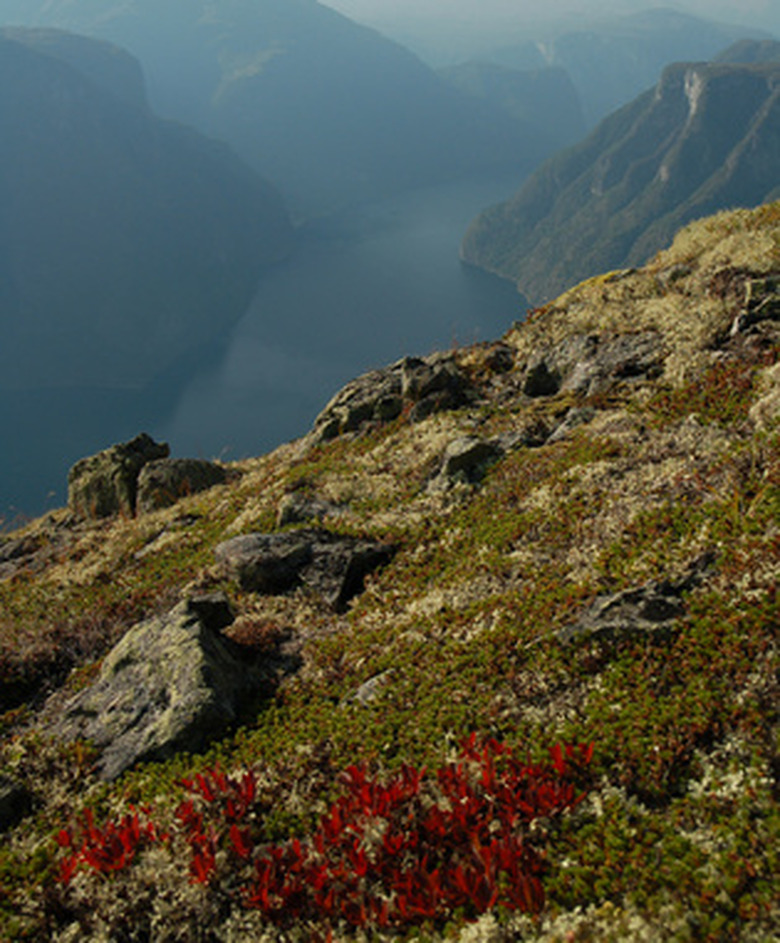Names Of Alpine Plants
Alpine biomes occur wherever there are mountains high enough to experience snowfall, according to the Blue Planet Biomes website. These alpine biomes are harsh, barren, frigid environments bombarded with high winds and low temperatures. They're also short on the carbon dioxide most plants rely on for the photosynthesis that feeds them. Some 200 plant species, however, have found ways of adapting to these forbidding places.
Purplefringe
Like all alpine plants, purplefringe hugs the ground. By standing just 4 to 16 inches high, this clumping perennial avoids buffeting from alpine winds. Its has coiled, long-stamened, white or purple flowers. They appear in cylindrical spikes during June and July, at the height of the abbreviated alpine growing season. Purplefringe's oblong-oval, silver-haired leaves become smaller as they ascend its stems. This biennial produces roots and foliage during its first year before flowering and dying in its second. It grows wild on partially shaded talus–loose, weathered bedrock–slopes in red fir forests at altitudes of 7,000 to 8,500 feet, according to the Lady Bird Johnson Wildflower Center.
- Alpine biomes occur wherever there are mountains high enough to experience snowfall, according to the Blue Planet Biomes website.
- By standing just 4 to 16 inches high, this clumping perennial avoids buffeting from alpine winds.
Cushion Pink
Cushion pink, or moss campion (Silene acaulis), forms inviting, 2- to 6-inch high cushions of soft green in rock gardens across the Western mountain states. From June to August, its glossy-leaved branches have abundant, single lavender or pink blooms. The plant clings to its mountainside perches–moist, limestone-based crevices–with deep taproots, according to the Lady Bird Johnson Wildflower Center. It grows in full sun.
Pygmy Bitterroot
A purslane family plant, pygmy bitterroot (Lewisia pygmaea) has narrow, fleshy green leaves extending up to 8 inches along the ground. Between May and August, the foliage clumps produce short stalks with small, solitary or clustered flowers. Heavy veining shades their white petals with pink. Their green throats have yellow stamens. After blooming, the plant dies back to re-emerge in autumn. Pygmy bitterroot grows wild in open, dry, gravel-soiled areas above the tree lines of North America's Western mountain ranges.
- Cushion pink, or moss campion (Silene acaulis), forms inviting, 2- to 6-inch high cushions of soft green in rock gardens across the Western mountain states.
- A purslane family plant, pygmy bitterroot (Lewisia pygmaea) has narrow, fleshy green leaves extending up to 8 inches along the ground.
Alpine Azalea
A familiar site on the heights of New Hampshire's Mount Washington, alpine azalea (Loiseleuria procumbens) is a dwarf, matting shrub. Less than 12 inches high, it has dense branches nearly hidden beneath tiny, oblong green leaves. From June to August, the plant blooms with clusters of two to five erect, white or deep pink bell-like blooms.
This perennial occurs in the alpine biomes of New England, Canada and Alaska, where it thrives in the arctic tundra, according to the Lady Bird Johnson Wildflower Center. It grows in partly shady locations with gravelly or moist, acidic–pH below 6.8–peat-based soils. Alpine azalea's roots, seeds and foliage may be toxic or fatal if ingested.
